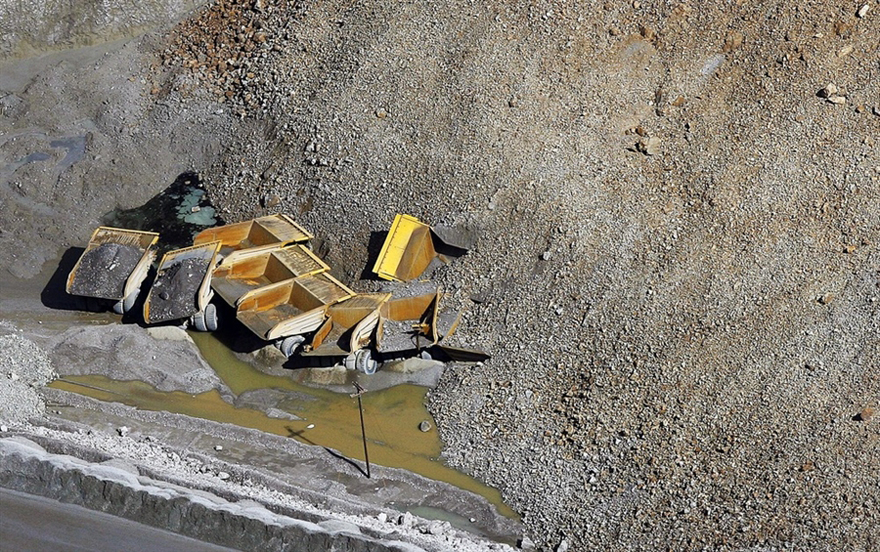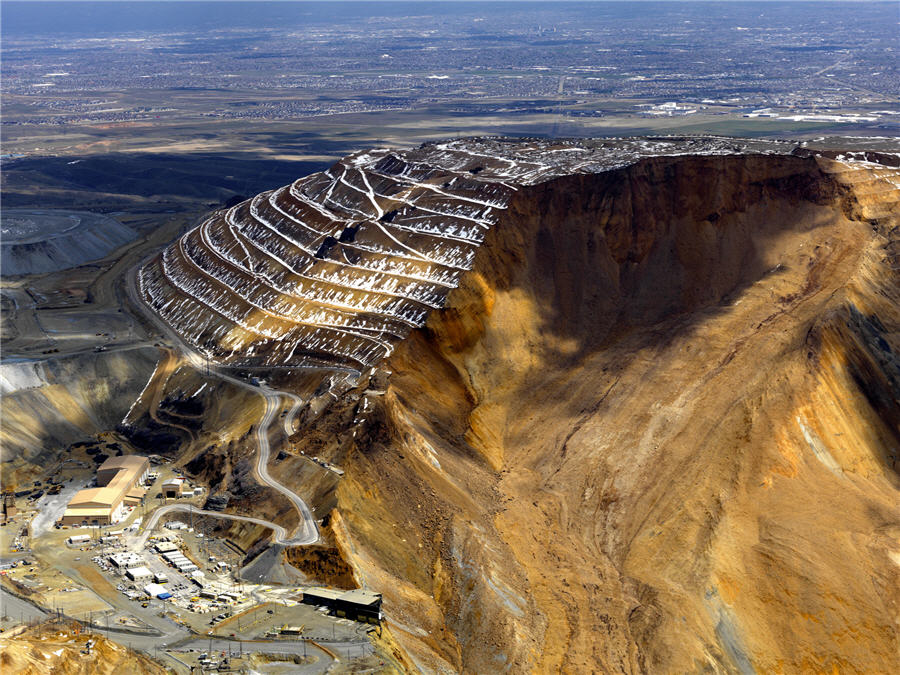This article first appeared November 2014

Bingham Canyon, 30 miles south of Salt Lake City, Utah has been mined since 1906. The mine has produced more copper than any mine in history – more than 19 million tonnes. At peak production represents 25% of total US copper production. World number two miner Rio Tinto bought Kennecott in 1989 and has invested more than $2 billion in modernizing the mine and another $450 million to clean up historic workings and ground water. This picture from the Library of Congress dates back to November 1942.

Today what was a mountain 108 years ago is a pit more than than three-quarters of a mile deep (that’s more than 200 stories high) and more than two and three-quarter miles wide across the top. The elevation of the mine drops from 8,040 feet to 4,390 feet above sea level. If you stretched out all the roads in the open-pit mine — some 500 miles of roadway — you’d have enough distance to reach from Salt Lake City to Denver.

On April 10, 2013 at 11:00 in the morning all employees are evacuated from the bottom of the pit after ground probes and radar monitoring equipment detect slope deformation increasing from 1mm a day to 5mm day. At 9:30 that same evening a slide along a geotechnical fault-line of the mine’s northeastern wall occurs followed by another 90 minutes later. An astonishing 160 million tonnes of material is moved by the avalanche with the rock moving at estimated speeds of 70 – 100 miles per hour. It’s the largest “man-made” landslide ever recorded.

The haul truck maintenance building (think more aircraft hanger than work shop) is sliced nearly in half by the slide, the pit access road disappears and 13-haul trucks are buried. The bottom of the pit is covered in debris nearly 200 feet deep. The two slides cause the equivalent of magnitude 5.1 and 4.9 ‘quakes’ and results in 16 smaller ‘aftershocks’.

Haul truck drivers ride about 18 feet above the ground thanks to 12.5 feet tires (that don’t last more than nine months and cost upwards of $20,000). The trucks are about the same size as a two-story townhouse. This image of that same truck work shop in 2010 is by Rawhead Rex.

Crews were back on the site three days after the slide to remove waste rock. Six millions tonnes of dirt is hauled are to build a new access road so that mining can resume. The task was completed in October last year, seven months ahead of schedule and limited output losses to 50% of capacity.
Haul and water trucks always have right of way and you quickly understand why. The 320-tonne haul trucks are shipped to the mine in pieces and assembled on site. 10 of the buried haul trucks have been recovered and five, put together from parts of different trucks, are back in service.

When fully loaded, a haul truck weighs more than 1.1 million pounds. Kennecott also uses seven haul-sized water trucks with 50,000-gallon tanks. These trucks constantly spray water onto roads to reduce dust, Bingham Canyon’s number one environmental impact.
Despite the disruption, in 2013 the mine produced 213,000 tonnes of copper, 192,300 ounces of gold, 2.2 million ounces of silver and 6,300 tonnes of molybdenum, using giant machines like this shovel and a fleet of more than 100 haul trucks.

From this in-pit crusher the ore is moved by conveyer belt, partly through a tunnel, to the processing plant. Rio Tinto is currently working on studies to extend Bingham Canyon’s life to 2029, including expanding operations underground after the discovery of a high-grade copper-gold skarn deposit located approximately 300 metres below the open pit.

The Bingham Canyon Concentrator plant. Due to the landslide some 170 workers took early retirement and another 40 were laid off or transferred elsewhere in Rio Tinto including Kelly Sanders, Kennecott CEO and President.
This image of the copper smelter and tailings infrastructure is from the mine’s new Virtual Visitors Center. I also got to try Kennecott’s virtual reality experience (in beta at the moment) using an Oculus Rift head-mounted display. It places you right in the middle of the action and is almost more immersive than being there in the flesh! The Visitors Center and outlook point was closed and parts of the structure moved ahead of the slide. The facility generated $2.8 million for its charitable foundation and received more than 3 million visitors since 1992.

My tour guides from left to right: Trevor Heaton, environmental engineer, Nate Foster, mine manager and Kyle Bennett, Rio Tinto Kennecott spokesperson. Thanks guys!
Images by MINING.com and Kennecott Rio Tinto unless otherwise specified. Thanks to Deseret News for use of their image.
10 Comments
RockRabbit
Beautiful pictorial of what could have been a disaster. Kudos to Kennecott and all of their employees.
fred
in 1973, I think, My tramp partner Ron Pembleton and Dan Harger worked in the Shaft beside the pit then. We stayed in a hotel there in town. Ate in this place, was a bar and Cafe, one night we came home from the Shaft, and there was a Health Sign on the door that
it was shut down for being dirty…spit, spit to late to spit…anyway I guess the pit took the Shaft, and town and it is not there anymore.
We worked on the Rope Raise. One day Dan hit the wall with the diesel mucker and it fell away, far away, down the raise. It was under the Shaft floor. Wow!!! The Engineers moved it three times to avoid the old Stope, then hit it right on. Well, we filled it up with muck and topped it off with cement. Old under the ground Memories. We left there and went to Lead, South Dakota, you guessed it. HOMESTAKE 8300 foot level. TakeCare you Miners. [email protected]
Sergo Cusiani
Would be interesting to view the pit design before the slide took place. That is, the drawing plan, designed by (supposedly) mining engineer, showing the outlines of the pit at the time. My suggestion is the slide was a result of improper operation. The question is, Had the accident been “planned” accidentally by the pit designer or had the mine management just ignored the correct (if any) design?
The original plan can answer the questions. Just professional curiosity.
http://www.geo-logaritmica.com/images/_bingham.JPG
Fred Barker
Any well designed pit should cave in the day after you finish mining the ore. A job well planned and executed by Kennecott. Fred Barker
Bobby44
Good presentation! I have worked for Rio Tinto and my experience has always been positive. Good call at 5mm. May the grand old mine continue safely.
Naun Claros S.
If the incident was followed to the point that no human victims were in the toll, good call! why then the trucks were not taken out of the way? Did the signal of danger come too late for the trucks to be driven out? I believe there were insurance policies covering not only the damage but also the period or recuperation without production, not enough money for new trucks? My point is that a dozen trucks with damage in the operation no matter how well repaired are not at their best anymore and represent a danger to the workers as a whole….don´t they? Great pictures!
Wayne Johnson
This may be a stupid question, but I have not been able to find the answer…did the slide occur primarily in previously mined materials (i.e. a dump), or was it mostly in situ stuff?
Geoff the geo
I was a visitor to the pit lookout possibly in the mid 1980s and was impressed by the size of the thing – and was startled to see a train emerge from a tunnel in the distance! When did the mine go to trucks only?
Larry Southwick
Unfounded propositions
I’m not certain how any knowledgeable professional could make such baseless and snide inferences to the effect that (1) the mining “plan designed by (supposedly) mining engineer”, (2) ignorant claims of possible “improper operation”, (3) outrageous assertions that “had the accident been planned?” and (4) totally unfounded assertions that “mine management just ignored correct (if any) design.”
Other posts on this web site by this same individual (re closing of Cliffs Wabush mine in Canada) were equally preposterous and unfounded. No technical and hazardous endeavor could be conducted on the irresponsible ground rules being insinuated.
There seems to be a fixation against mining as a business for profits. Mining operations such as Bingham Canyon illustrate a uniform
management, employee and union attention to effective safety policies, monitoring of same, checks and balances between divisions and services, and well qualified mine and plant engineering.
Industrial activity involves risks, but as stated by others here and certainly from a review of reports on the slide, no “tempting of fate” was found in the investigations. If there is evidence to the contrary in this instance, then it would help if such information were provided before making such serious accusations. Speculation and a plethora of opinionated “may’s” and “might’s” do not substitute for actual facts.
Baseless stink bombs with malicious intent do not an insight reveal nor a contribution make. Nor does any professed professionalism excuse such offensive remarks.
Outside of all that, it was a great collection of photos!!. Kennecott did a professional job getting everyone out of the mine in time and getting it back into production quickly.
Larry M. Southwick
AuntSue
Fascinating! My dad worked there during high school, until he graduated from college. Always a fun place to visit. So glad that RioTinto handled this responsibly with no loss of life. Proud you are a Utah industry.